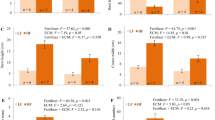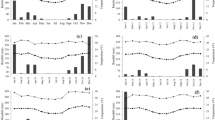Abstract
This study assessed the influence of various operational transplanting procedures on J-rooting compared to a no transplanting approach of direct sowing into Hiko trays. Eucalyptus dunnii Maiden and E. pilularis Smith seedlings were examined. All transplanting treatments increased severity and incidence of J-rooting for both species. Gently loosening seedling plugs by hand prior to their removal from cells of 512 trays and gentle manual production of seedling planting holes (dibbering) in potting media in Hiko cells, rather than mechanically loosening and mechanical dibbering, reduced the incidence of J-rooting for both species. Disturbance of seedling plugs from mechanized loosening and increased compaction from mechanical dibbering are believed to have a negative effect on root development. Direct sowing produced seedlings with highest root quality when measured at 27 weeks.
Similar content being viewed by others
Notes
Heagney G, Thomas D, Henson M, 2006, Seed source affects seedling quality in E. pilularis seedlings. Forests NSW, 22 pp "unpublished report".
Heagney G, Thomas D, Henson M, 2006, J-root formation in a number of our eucalypt species planting stock is decreasing seedling quality. Forests NSW, 20 pp "unpublished report".
References
Bail IR, Pederick LA (1989) Stem deformity in Pinus radiata on highly fertile sites: expression and genetic variation. Aust For 52:309–320
Brady NC, Weil RR (2002) The nature and properties of soils. Pearson Education limited, New Jersey
Burdett AN, Simpson DG, Thompson CF (1983) Root development and plantation establishment success. Plant Soil 71:103–110
Burdett AN, Coates H, Eremko R, Martin PAF (1986) Toppling in British Columbia’s lodgepole pine plantations: significance, cause and prevention. Forest Chron 62:433–439
Campbell KA, Hawkins CDB (2004) Effect of seed source and nursery culture on paper birch (Betula papyrifera) uprooting resistance and field performance. Forest Ecol Manag 196:425–433
Carnegie AJ (1999) Blow-down in young Eucalyptus pilularis plantations in New South Wales. State Forest of NSW, Forest Research and Development Division. 6 pages, Sydney
Cedemon ED, Mangaoang EO, Gregorio NO, Pasa AE, Herbohn JF (2005) Nursery management inrelation to root deformation, sowing and shading. Ann Trop Res 27:1–10
Folk RS, Grossnickle SC (1996) Determining field performance potential with the use of limiting environmental conditions. New For 13:121–138
Haase DL, Batdorff JH, Rose R (1993) Effect of root form on 10 year survival and growth of planted Douglas fir trees. Tree Planters Notes 44:53–57
Harrington TB, Howell KD (1998) Planting cost, survival and growth one to three years after establishing loblolly pine seedlings with straight, deformed, or pruned taproots. New For 15:193–204
Harrington TB, Gatch JA, Price TS (1999) Stem sinuosity, tree size, and pest injury of machine-planted Loblolly pine with bent versus straight taproots. Southern J Appl For 23:197–202
Harrison DF, Cameron KC, McLaren RG (1994) Effects of subsoil loosening on soil physical properties, plant root growth, and pasture yield. NZ J Agric Res 37:559–567
Hunter SC, Maki TE (1980) The effects of root-curling on loblolly pine. Southern J Appl For 4:45–48
Mason EG (1985) Causes of Juvenile instability of Pinus radiata in New Zealand. New Zeal J For Sci 15:263–280
Mattsson A (1996) Predicting field performance using seedling quality assessment. New For 13:223–248
Murphy MS, Harrington TB (2004) Stem sinuosity of loblolly pine seedlings as influenced by taproot shape. General Technical Report Southern research Station, USDA Forests Service (No. SRS-71), pp 465–468
Mullan GD, White PJ (2002) Seedling quality: making informed choices. Bushcare and The Department of Conservation and Land Management of Western Australia, Perth, 24 pp
Ritchie GA (1984) Assessing seedling quality. In: Duryea ML, Landis TD (eds) Forest nursery manual: production of bareroot seedlings. Martinus Nijhoff Dr. W. Junk Publishers, The Hague
Simpson DG (1990) Cold hardiness, root growth potential, and field performance relationships in interior spruce, lodgepole pine, Douglas fir, and western hemlock seedlings. Can J For Res 20:566–572
Sislov A (1998) J-root in tubestock tree seedlings. Agroforestry News 7:27
South DB, Harris SW, Barnett JP, Hainds MJ, Gjerstad DH (2005) Effect of container type and seedling size on survival and early height growth of Pinus palustris seedlings in Alabama, U.S.A. Forest Ecol Manag 204:385–398
Stape JL, Gonclaves JLM, Goncalves AN (2001) Relationships between nursery practices and field performance for Eucalyptus plantations in Brazil. New For 22:19–41
Woods FW (1980) Growth of loblolly pine with roots planted in five configurations. Southern J Appl For 4:70–73
Zou C, Penfold C, Sands R, Misra RK, Hudson I (2001) Effects of soil air-filled porosity, soil matric potential an dsoil strength on primary root growth of radiate pine seedlings Plant and Soil 236:105–115
Acknowledgements
We would like to thank Forests NSW nursery staff at Inverell Nursery and Grafton Nursery for assistance in production of seedlings. Barry McGlasson (University of Western Sydney) very generously supplied the penetrometer. We gratefully thank Darrel Johnstone and Annette Johnstone for technical assistance when harvesting seedlings.
Author information
Authors and Affiliations
Corresponding author
Rights and permissions
About this article
Cite this article
Thomas, D.S., Heagney, G.A. & Harper, P. Nursery transplant practices determine seedling root quality of two subtropical eucalypts. New Forests 36, 125–134 (2008). https://doi.org/10.1007/s11056-008-9088-5
Received:
Accepted:
Published:
Issue Date:
DOI: https://doi.org/10.1007/s11056-008-9088-5




